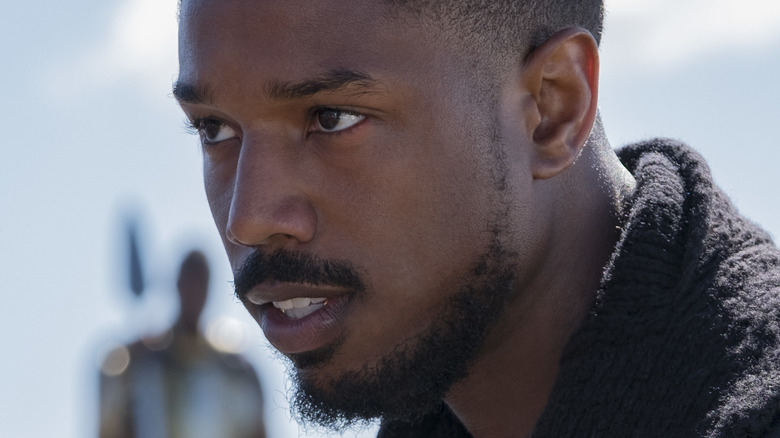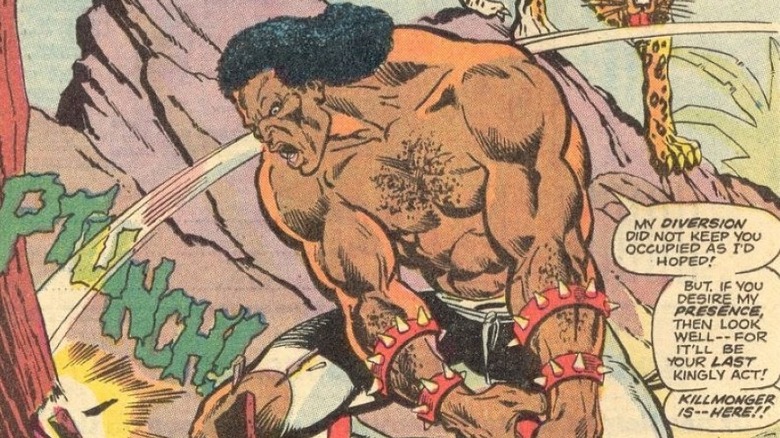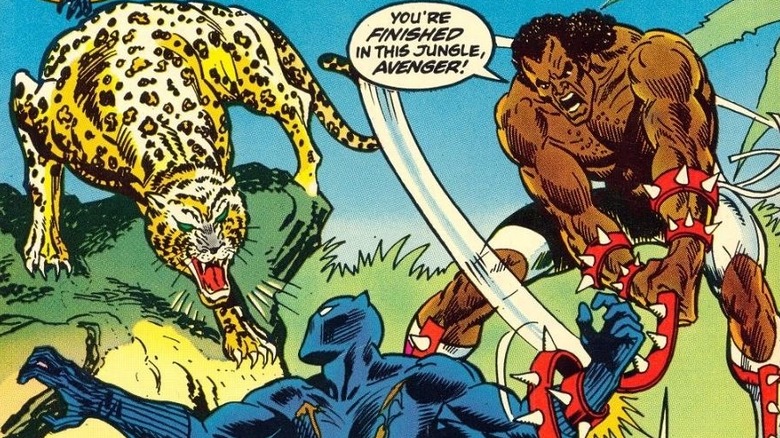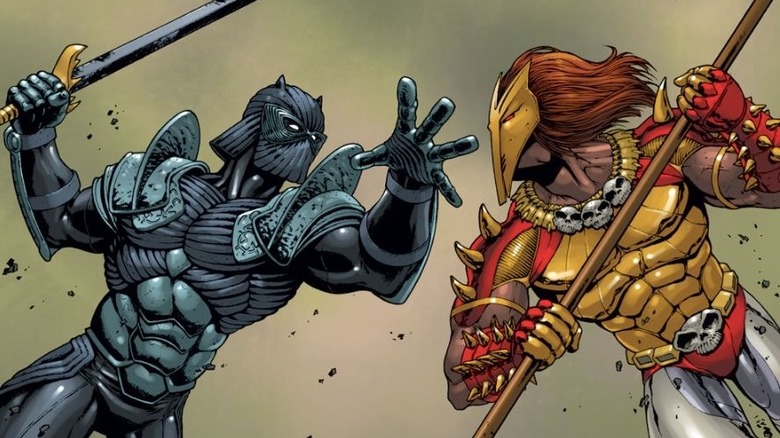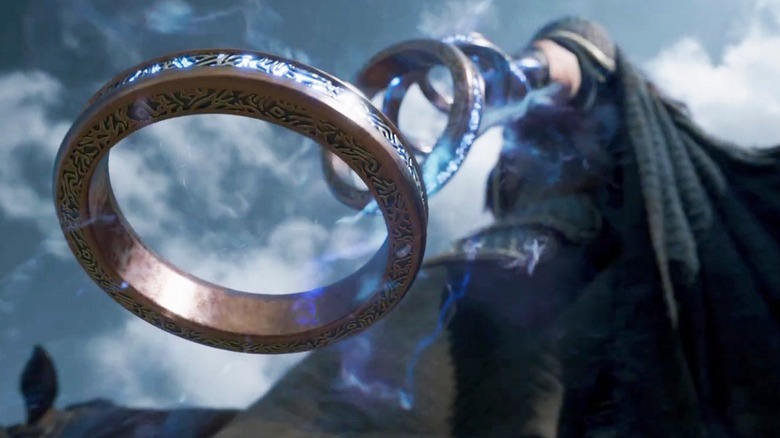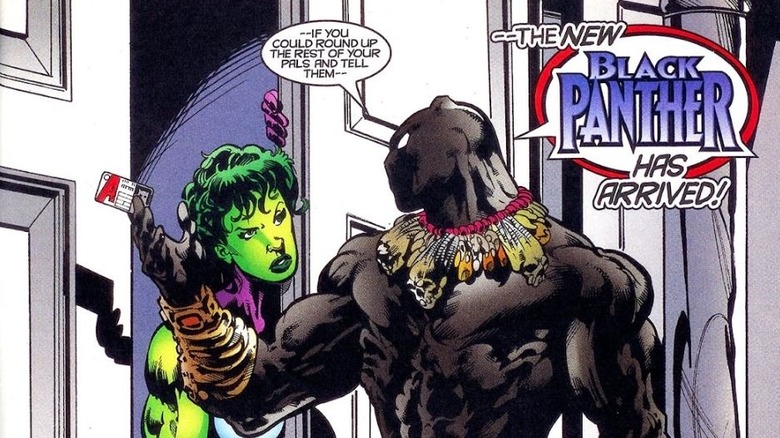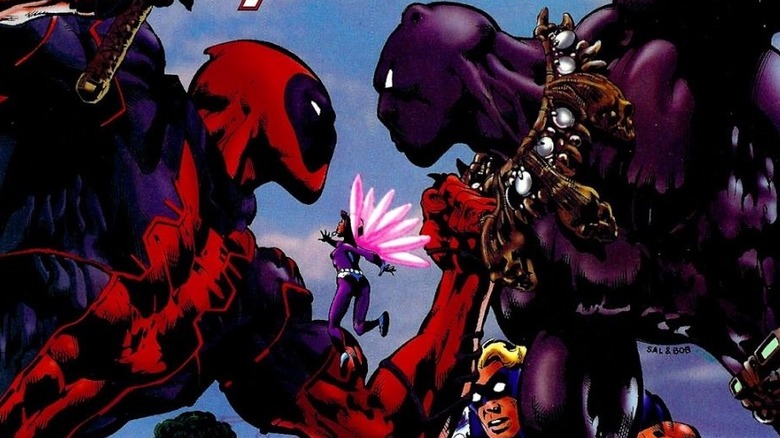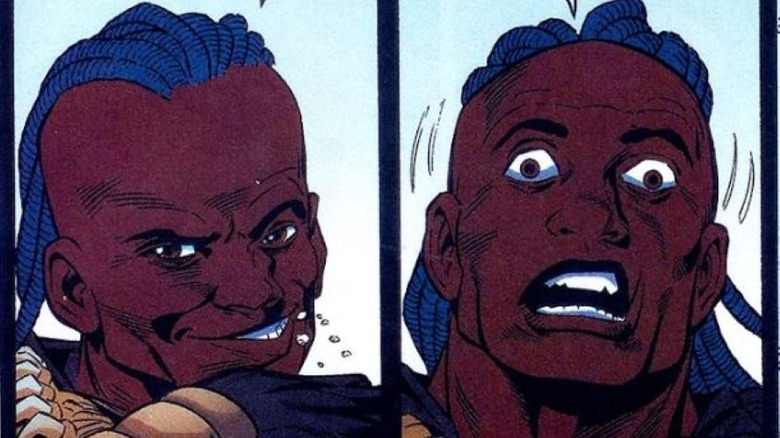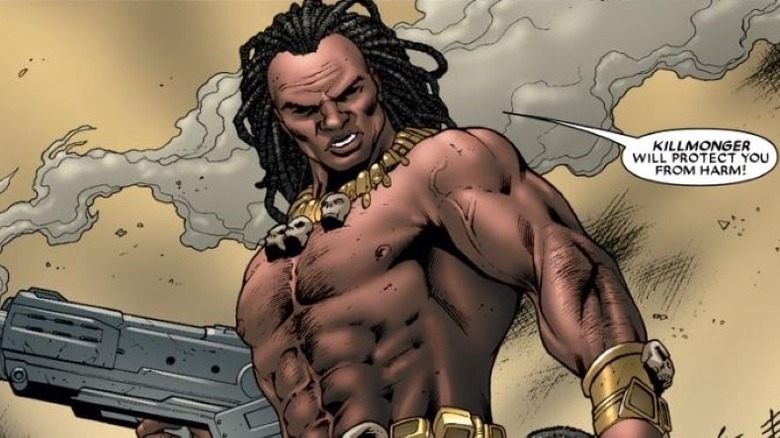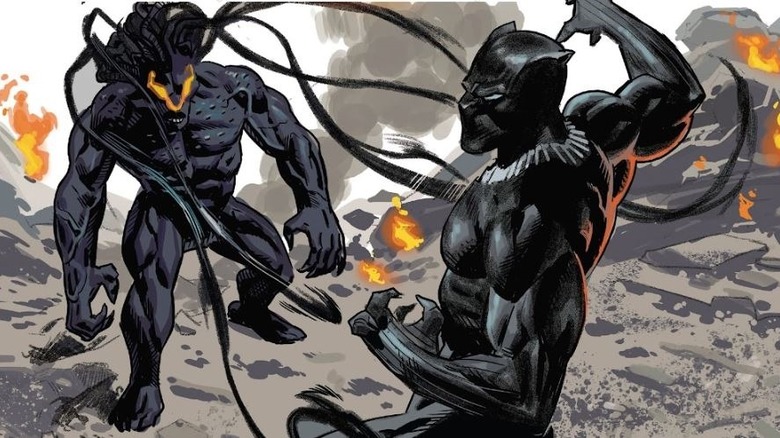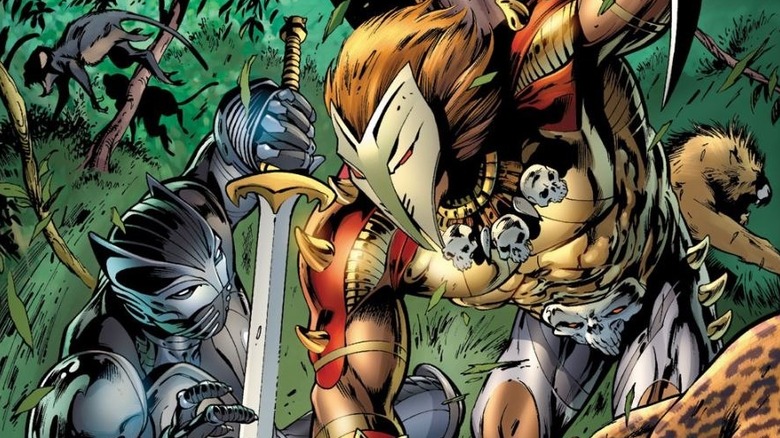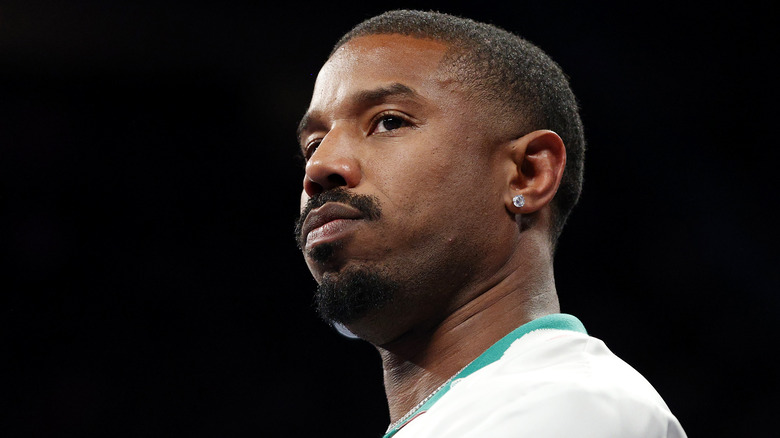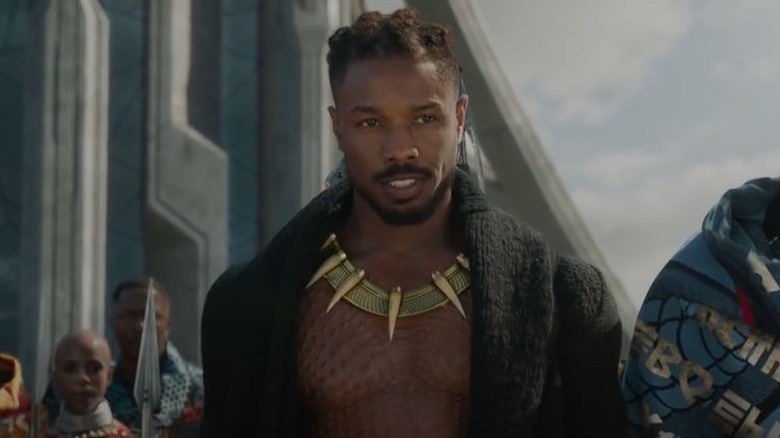Facts Only Huge Fans Know About Black Panther's Killmonger
Widely considered one of the best villains in the Marvel Cinematic Universe, Michael B. Jordan's portrayal of Erik Killmonger turned a relatively unknown comic book antagonist into a instantly popular character. Enacting his unique form of vengeance, Killmonger's rise to the throne in 2018's "Black Panther" is a riveting tale of one man's fight against the monarchy that he believes betrayed him. There is even an argument that he could be considered a protagonist of the film, as he is an anti-colonialist who kills terrorist Ulysses Klaue and only intends to make Wakanda a stronger nation. Killmonger's plan to overthrow the Wakandan royalty may be violent, but his intentions are righteous, making him a complex villain ripe for audience approval.
As compelling as the MCU's version of the long-standing Black Panther villain may be, there is still much about Erik Killmonger's backstory that didn't make it into the live-action adaptation. In our comprehensive exploration of one of Marvel's most complex and underappreciated supervillains, we'll learn how the revolutionary's complicated comic history made him an ideal choice for Black Panther's debut film, and how Michael B. Jordan was perfectly cast as the MCU villain.
First appearance and comic book origins
Like his MCU counterpart, the comic book version of Erik Killmonger is a native of Wakanda who is orphaned at an early age. However, the literary Killmonger, whose true name is N'Jadaka, loses his parents to raiders sent by Ulysses Klaue to uncover Wakanda's secrets. Raised overseas in a life of servitude under one of the men who murdered his parents, N'Jadaka grows to become resentful for losing out on the life he should have lived in Wakanda. The live-action and comic book versions of Killmonger share several commonalities, such as having an impressive education, because the character's origins were not completely clarified in the comics until the 2018 titles "Killmonger" and "The Rise of the Black Panther."
The first appearance of Erik Killmonger occurs in the 1972 series "Jungle Action." In the sixth issue of the series, T'Challa returns to Wakanda in hopes of reconnecting with his homeland after working with the Avengers in New York. But attacks on local villages capture the hero's attention, leading him to discover a new threat in the jungles of Wakanda, the dangerously angry Killmonger. The treacherous new villain would become a thorn in T'Challa's side for years to come, as Killmonger believes himself to be dominant and more capable of leading Wakanda. Unfortunately for him, he dies almost as many times as he tries to defeat his sworn enemy.
His loyal pet leopard
One trait of the comic version of Killmonger that went unexplored in the MCU was his affinity for animals, specifically his pet leopard Preyy. In the books, N'Jadaka is commonly accompanied by his loyal pet, before the animal is killed by an enemy while Killmonger reigns over Wakanda as the new Black Panther. According to the Official Handbook of the Marvel Universe, Preyy was more than an average leopard, which would be formidable enough. The cat has increased strength and speed, and is particularly skilled at using its natural weapons, moreso than similar animals and average humans.
Appropriately, Killmonger's affection for the leopard species is subtly represented in "Black Panther." It is difficult not to notice the differences in Killmonger's vibranium-powered super suit compared to the version worn by Chadwick Boseman's Black Panther. The villain's outfit is titled the Golden Jaguar Habit, representing a creature more fitting to the character's American origins, while T'Challa embodies the more localized panther. The spotted design and brighter colours of Killmonger's costume may also acknowledge the character's feline friend from the comic books.
Commander of a zombie army
After Erik Killmonger's premiere in "Jungle Action" #6, the villain's larger intentions to take control of Wakanda are revealed. With the nation's protector standing in his way, Killmonger throws every obstacle in T'Challa's way. Quickly running out of capable opponents for his enemy, Killmonger finds a loophole in the form of the Resurrection Altar. Hidden in the mountains of Wakanda, not only can the mystical altar bring the dead back to life, but it can bestow extreme power on someone due to its radioactivity. Killmonger takes advantage of the sacred slab by using it to create an army of powerful zombies called the Death Regiments.
As an ongoing plot throughout multiple issues of "Jungle Action," members of the Death Regiment are sent to defeat Black Panther, including Salamander K'Ruel and King Cadaver. Finally, after overcoming every zombie and enemy that comes at him, T'Challa gets his one-on-one battle with Killmonger. However, weakened by endless fighting, T'Challa nearly loses the final confrontation, but is saved by a young child named Kantu who he had previously helped. Killmonger falls off a cliff to his death during the climax of "Jungle Action" #17, the first — but not the last — time that Killmonger will die.
He was resurrected by the Ten Rings
Fans would love to see Michael B. Jordan's version of Erik Killmonger return to the live-action cinematic universe. Thankfully, comic books have already laid out a path for the Wakandan to be resurrected and it has ties to another MCU film. "Shang-Chi and the Legend of the Ten Rings" introduced audiences to the live-action version of the powerful title weapons. In the comic books, the Ten Rings of Power have a storied history and unique abilities, especially when utilized by the Mandarin, who's much more dangerous than his MCU counterpart.
"Iron Man 3" introduced the Mandarin, with Ben Kingsley portraying a fictional representation of a larger organization, while "Shang-Chi" retconned the character slightly with Tony Leung's Xu Wenwu taking the name. Alternatively, the comic version of Mandarin is one of Iron Man and the Avengers' greatest earthbound threats. In the fifth "Iron Man Annual" comic, the titular character pays a visit to his royal friend T'Challa in Wakanda just in time to collide with a resurrected Killmonger. Black Panther teams up with his Avenger ally to defeat N'Jadaka once again, only to discover that he is an animated corpse brought to life by one of the Mandarin's powerful Ten Rings.
He almost joined the Avengers
N'Jadaka returned many years later in 1999's "Black Panther" Vol. 3, #13. However, this time around, T'Challa's archnemesis played by the rules, challenging the king to a ritual of combat for leadership of Wakanda. After spending an entire evening fighting in hand-to-hand combat, Killmonger finally bested the Panther, rightfully earning his place as chieftain of the Panther Clan.
Wasting no time, N'Jadaka becomes an all-new, much darker version of the Black Panther. One of his first orders of business is capitalizing on his Avengers membership card. Much to the disappointment of the acting roster, including Iron Man, She-Hulk, and Goliath, Killmonger's mantle of Black Panther automatically enlists the villain as a full-fledged Avenger. He even goes on a mission with the team, who quickly find themselves facing ethical debates with the newly minted Panther and his trigger-happy, take-no-prisoners methods. Killmonger finally reveals that he's joined the Avengers because of his childhood dream of uniting Wakanda and America, but the warrior "can't stand to be in the presence of such gutless people," and quits. Before he leaves, he still proves himself a worthy teammate against their latest antagonist, everybody's favorite Merc with a Mouth, Deadpool.
Killmonger vs. Deadpool
Although short-lived, Killmonger's time as Black Panther is not without the odd bad guy trying to mess things up for him — in this case, Reverend Doctor Michael Ibn al-Hajj Achebe, another former usurper of the Wakanda throne. The insane Achebe and his chatty hand puppet Daki devise a plan to take out the new Black Panther by hiring a special mercenary to steal Killmonger's beloved pet leopard, Preyy. After a heated debate about who gets to keep Achebe's hand puppet, Deadpool agrees to take on the job.
Assisted by Titania and Constrictor, Deadpool achieves the capture of the big cat, but not without incidentally grabbing Avenger member Triathlon in the process. Angering Killmonger and his temporary teammates, the Avengers descend on Wade Wilson's crew and win the day. During the battle, however, Deadpool reminds the new Black Panther of his villainous ways and that he can never change. Meanwhile, despite overcoming his enemies, Reverend Doctor Achebe slips away after murdering Killmonger's pet feline.
The heart-shaped herb poisoned him
Despite acting as Chieftain of the Panther Clan and wearing the superhero costume, N'Jadaka's ceremonial crowning as the Black Panther is not yet complete. By Wakandan law, Killmonger is still required to complete the Rite of Ascension, and only then can he eat the heart-shaped herb that granted T'Challa his special abilities. By "Black Panther" Vol. 3, #24, Killmonger is ready to take his tests. Although T'Challa is willing to waive the trial, N'Jadaka insists, wanting to prove that he is capable.
The book describes the Rite of Ascension as this: "Step one: beat up six of Wakanda's fiercest warriors. Step two: a bunch of other stuff." Killmonger overcomes his challengers in a record four-and-a-half minutes, and it's decided that he can skip the remainder of the trials. Finally proving himself as the rightful Black Panther, N'Jadaka swallows the heart-shaped herb in haste. Unfortunately, because he is not a direct descendant of the Panther Clan royal lineage, the sacred fruit poisons Killmonger. In moments, the short-lived Panther is presumed dead, once again leaving T'Challa as the Chieftain of his clan.
He became champion of another African country
Erik Killmonger survives his poisoning by the heart-shaped herb and later creates his own synthetic version while living abroad in the U.S. The next time N'Jadaka returns to Africa, it's not to Wakanda, but the neighboring country of Niganda. Another fictional nation, the Democratic Republic of Niganda is jealous of and less prosperous than its vibranium-rich neighbor. Facing territory disputes, the two African countries have a long history of war, especially with Niganda's rotating door of dictators. One of the nation's more dastardly leaders, M'Butu, allowed a geneticist to perform his unethical experiments within Niganda's borders, creating monsters out of many of the country's animals.
When Killmonger arrives in Niganda, in "Black Panther" Vol. 4, #35, he wins over the hearts of the locals by defeating many of the local monsters. N'Jadaka also seemingly ends the fighting between the multiple different factions vying to control Niganda. However, it's later revealed that Killmonger was assisted by the U.S. government in gaining control of the impoverished country, and many of his heroic efforts were staged. Always the villain, Killmonger betrays the U.S. sanction and uses his newfound power to wage war against Wakanda. This leads to another one-on-one battle between the heads of two states. As in their many encounters before, Killmonger gets the better of Black Panther, nearly killing the hero, but T'Challa is narrowly saved by Monica Rambeau (aka Photon) who, once again, kills the antagonist.
Killmonger's alien symbiote
More recently in Wakanda's comic book history, the country's reach has expanded across space and time in what is now known as the Intergalactic Empire of Wakanda. Hunting for the source of vibranium, a small faction of Wakandans end up trapped in a "temporal anomaly," where they settle on a new planet in the name of their homeland. Thousands of years pass for this lost tribe, which develops into a galactic empire spanning multiple systems. Akin to the earthbound Wakanda, the Intergalactic Empire has a would-be usurper of its own, N'Jadaka, named after the original Erik Killmonger.
In "Black Panther Vol. 7, #2, the space-bound N'Jadaka comes across a sole surviving symbiote, similar to the alien species that merges with Spider-Man, and bonds with the creature in order for both of them to survive. N'Jadaka becomes Emperor of the Intergalactic Empire, and as such is targeted in a fight with Teku-Maza rebels, losing his life. The symbiote survives the disaster and carries an imprint of N'Jadaka's personality and memories. Vowing revenge on Wakanda Prime, the symbiote finds its way to Earth. Meanwhile, followers of the original Killmonger use the Resurrection Altar to bring their champion back. The symbiote attaches itself to the corpse before the restoration, trapping itself and N'Jadaka's mind in the body of Erik Killmonger. The three consciousnesses subsequently work together in another attempt to defeat King T'Challa.
He has never lost a one-on-one fight with T'Challa
Combing through the long published history of Erik Killmonger, a pattern emerges that showcases just how physically superior he is to T'Challa. For most superheroes, facing their nemesis comes with a series of wins and losses. However, at the end of the day, most heroes find a way to triumph over their enemies. While that is true for Black Panther's many fights with Killmonger, they almost always end with an assist from an outside party leading to the hero's victory.
In every situation where Killmonger and T'Challa face one another without interference, Killmonger has come out the victor — especially if the hero is without his powers and suit. The only example of T'Challa winning a fair match with Killmonger occurs during the 2018 live-action film "Black Panther." But even during the movie, N'Jadaka gets the better of his rival during their fateful fight at Warrior Falls. It is enough to say that Killmonger is Black Panther's most formidable foe, and thankfully he dies enough times that T'Challa does not have to face him often.
Michael B. Jordan's dedication to becoming Killmonger
Inarguably, the first "Black Panther" movie would not be the same without Michael B. Jordan's portrayal of the seasoned antagonist Erik Killmonger. While the actor seemed to fit the role effortlessly, the truth is that Jordan took his interpretation of the comic book villain extremely seriously. "I just had to dedicate everything I had to getting in shape and becoming Killmonger," the actor said during a press event (per Men's Journal). "I was doing weapon training, gun training, and a lot of mixed martial arts."
Jordan is also a comic book expert when it comes to Black Panther, as proven by his Google Autocomplete Interview with Wired. The actor also dove deep into his character's psychology, keeping a journal as Killmonger. "I have journals or diaries or whatever for every character I have," Jordan revealed on The Late Show with Stephen Colbert. "For [Killmonger], his was particularly dark. It was a very sad journal." Jordan reportedly went to such a dark place that he went to therapy (per USA Today) after spending much of the filming isolating himself to get into character.
Hidden details of the MCU's Killmonger
Similar to many of the other characters appearing in "Black Panther," there are many subtle and hidden details about Erik Killmonger that make him even more interesting. For example, his weapon choices say a lot about the character, such as his decision to use two blades during his first fight with T'Challa, as opposed to using a shield like his opponent. Killmonger also breaks a spear during the film, opting to use two shorter weapons. This style of fighting with a short spear comes from the Shaka Zulu region of South Africa, showcasing the character's knowledge, expertise, and attachment to African culture.
A versatile character with Killmonger's depth also requires a diverse wardrobe. He concludes the film wearing the Golden Jaguar vibranium-powered suit, but undergoes a few significant clothing changes to get there. Audiences are introduced to Killmonger in the museum scene, where he is operating in a street-wise hip-hop-inspired outfit (via Garage). The character then transitions into tactical military-style gear, complete with a jackal mask that has its own secret history. Before Killmonger wears his royal garb as the rightful champion of Wakanda, he battles T'Challa without a shirt. One of the more shocking moments of the movie is the reveal of N'Jadaka's scarification. Each one of the raised bumps on his body is self-inflicted to represent a person that he has killed; the film took inspiration for this from real-world Oceanic tribes (per Affinity Magazine). Every inch of Killmonger's body is marked — by his never-ending quest for vengeance.
